A Xenoblade Chronicles 3 Critique: Earnest, Complex, and Bloated
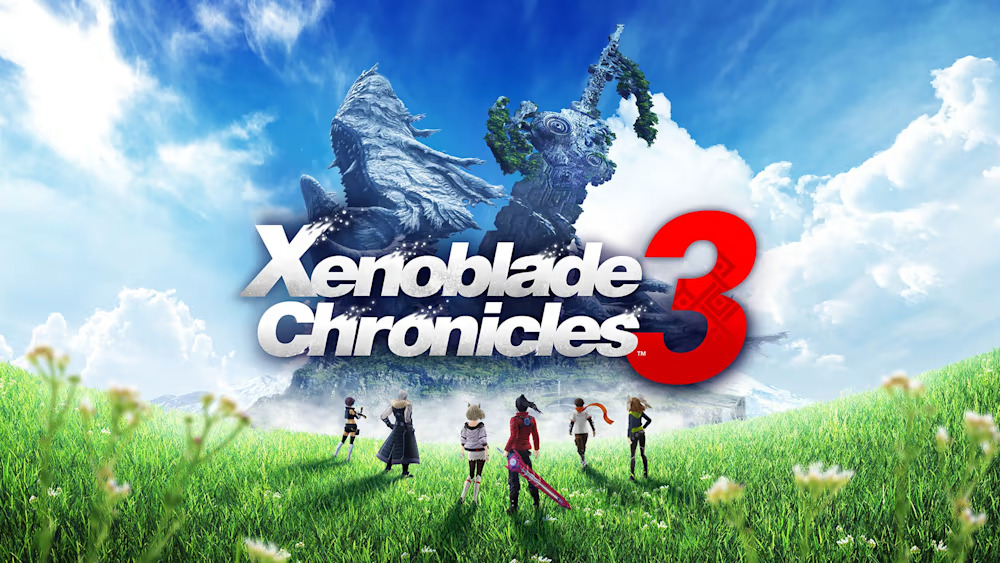 I'm the guy with the gall...to fairly critique this game.
I'm the guy with the gall...to fairly critique this game.Disclaimers
- Spoilers will be kept to a minimum, and major ones will be hidden with spoiler tags (hover over them to reveal them).
- I completed the game and finished the many of the game's sidequests. This took me about 100 hours.
Introduction
Almost 5 years after the release of Xenoblade Chronicles 2, Xenoblade Chronicles 3 is finally here. It's not necessarily a conclusion to the beloved series, but can be considered the end of the main story that started with Xenoblade Chronicles on the wii.
In other words, Xenoblade Chroincles 3 is a stopping point. A resting place. A period in which the team and the fans can gather their thoughts, reflect on past experiences, and ponder where the series will go next. Xenoblade is not gone, but it's likely to go away for a while.
So, as the conclusion a stopping point for this beloved JRPG series, how does Monolith Soft's latest entry in the Xenoblade Chronicles series fare?
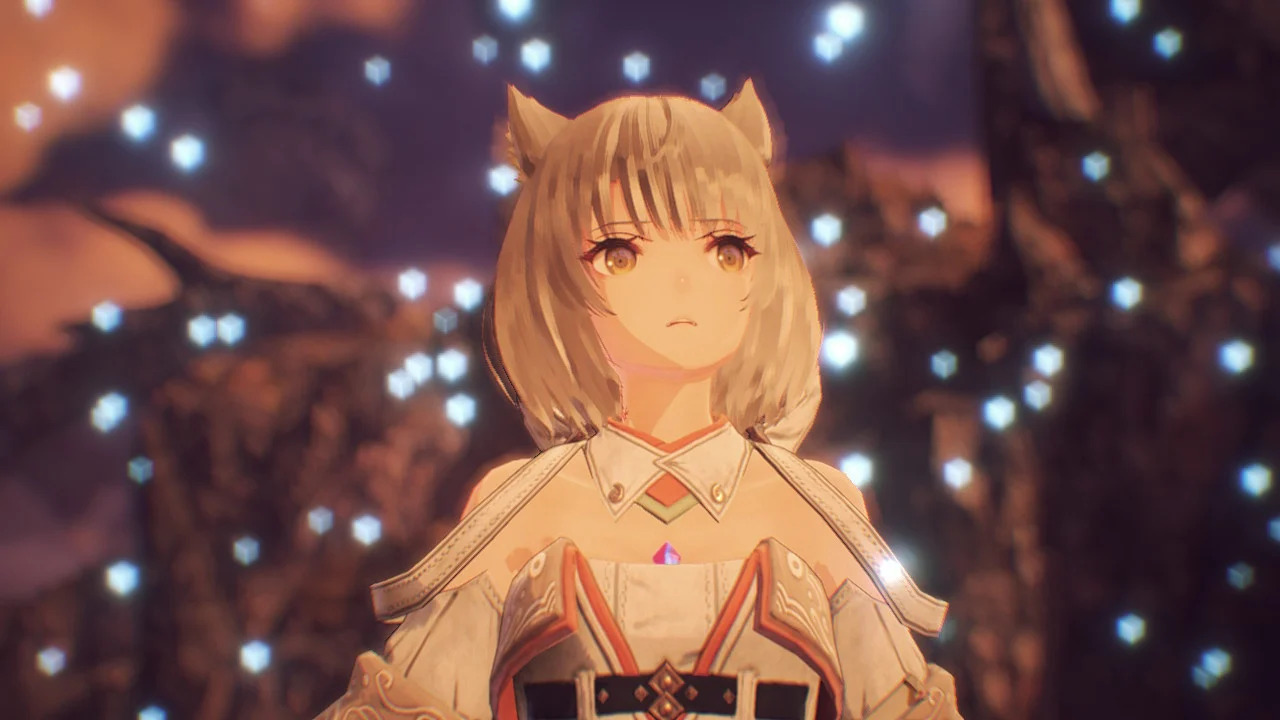 It's been fun...at times...to analyze what went right, and what went wrong, with Xenoblade Chronicles 3.
It's been fun...at times...to analyze what went right, and what went wrong, with Xenoblade Chronicles 3.
Given that Xenoblade Chronicles 3 takes a minimum of 62 hours to beat, which doesn't include any or sidequests, there's no way that I'd be able to answer that question in a two-page essay. And since game reviewers don't need to finish games anymore, I'd like to offer as both a huge Xenoblade fan, and as someone who has spent a lot of time with this game.
So, much like Xenoblade Chronicles 3 itself, I'm going to take way too long to tell you what I think and how I feel. I suppose I could consider this long review as revenge for the time I spent/enjoyed/wasted on Xenoblde Chronicles 3. This game is certainly a ride, but it's not necessarily a fun one from start to finish.
Let's get started.
Outstanding in Many Respects
In case it wasn't clear, Monolith Soft's work on Nintendo's consoles has always been exceptional. The environments in Xenoblade Chronicles 1 pushed Nintendo's aging Wii console to its limits, and Xenoblade Chronicles 2 on the Nintendo Switch upped the ante in many respects. It's no surprise, then, that Xenoblade Chronicles 3 continues that trend.
A Stunning Technical Achievement
Both artistically and technically, this game is leaps and bounds ahead of anything else on the Switch. A quick comparison to this screenshot of Pokemon Scarlet and Violet, another first-party Nintendo game, should speak for itself.
The landscapes are vast, the lighting system is , and there is a significant increase in the number of onscreen characters and enemies. More impressive is the fact that, despite all of these improvements, there's very little pop-in and that many games nowadays tend to (ab)use.
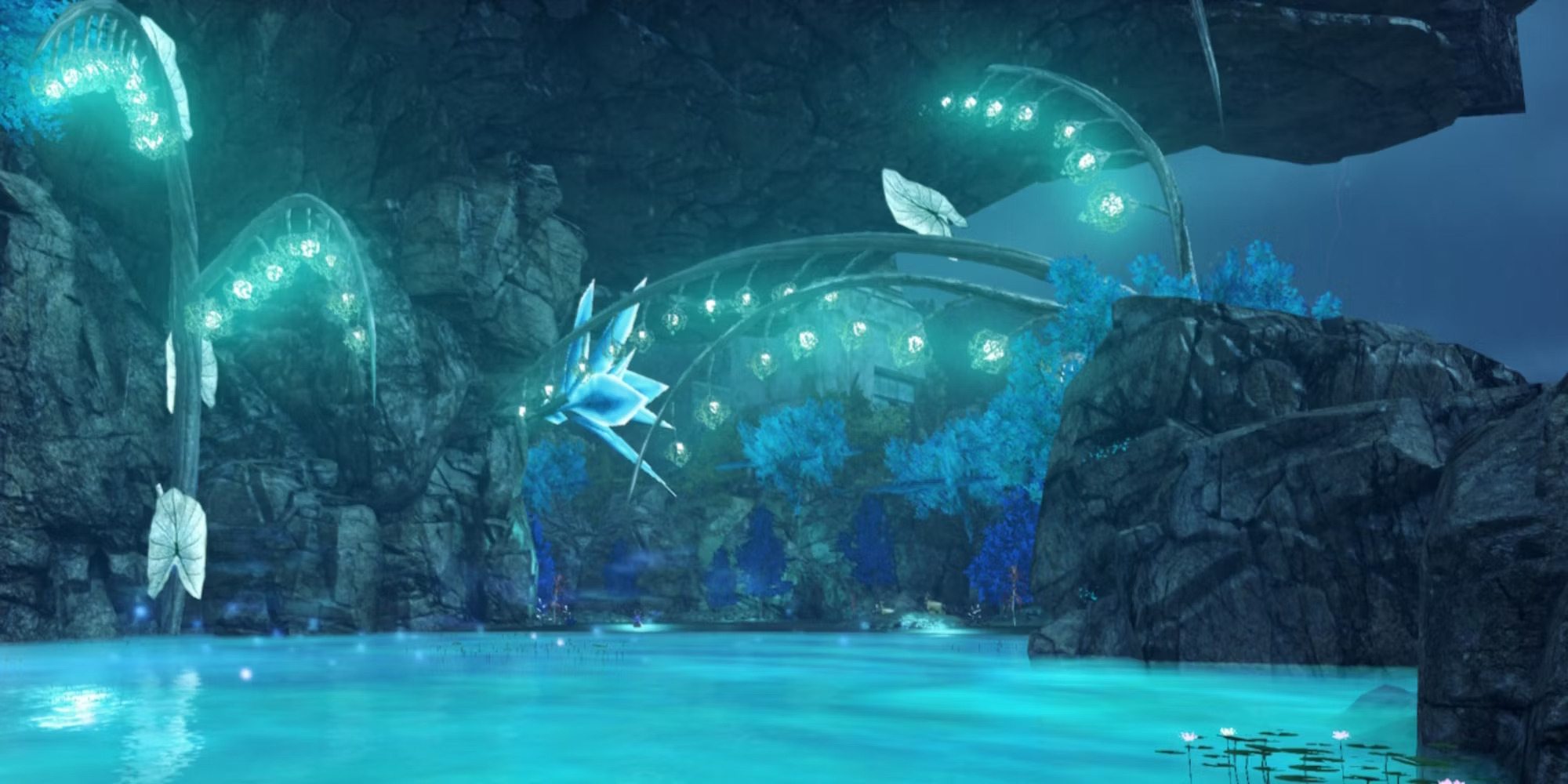 In addition to the game's technical chops, Xenoblade Chronicles 3 makes intelligent use of neon colors to make environments pop.
In addition to the game's technical chops, Xenoblade Chronicles 3 makes intelligent use of neon colors to make environments pop.
These improvements aren't simply for the pixel-counters and the framerate snobs, though. Instead, I'd argue that these improvements help Xenoblade Chronicles 3 feel like a real, living universe. Its biomes are teeming with personality and life, which helps evoke a nostalgic, childlike sense of adventure as players explore Aionios
This is important because exploration is a large part of Xenoblade Chronicles 3's appeal: much of the player's time will be spent traversing the game's varied, ethereal landscapes. Despite a lack of any real secrets to discover or treasures to find (which I'll get to later), I'll admit that simply being able to observe the sun setting behind a vast expanse of distant mountains for the first time was a real treat.
A Mature, Consistent Narrative
Let's talk about Xenoblade Chronicles 2, this game's predecessor, for a second. Its critical reception was divisive in many respects, but being "too anime" was a common refrain from its detractors. Even though I take issue with , I mostly agree with its sentiment: despite Xenoblade 2's attempts to establish a complex narrative that spans multiple universes, its efforts are undermined by the game's proclivity for fanservice, penis jokes, accidental boob touching, and ridiculous-looking outfits. This is made worse by a shoddy North American localization and some voice acting performances, which ensures that any attempts at humor land with a thud.
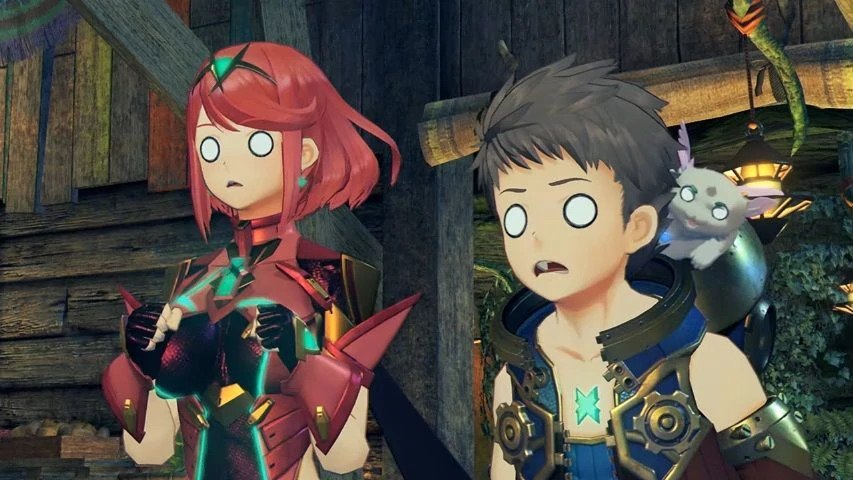 A Xenoblade Chronicles 2 scene in which Pyra and Rex have just been introduced to Tora's maid-outfit-wearing robot slave "companion". Silly and fun? Maybe. Something you'd want to share with your coworkers? Definitely not.
A Xenoblade Chronicles 2 scene in which Pyra and Rex have just been introduced to Tora's maid-outfit-wearing robot slave "companion". Silly and fun? Maybe. Something you'd want to share with your coworkers? Definitely not.
I'm not here to shame people for enjoying sexiness and silliness, but for a series like Xenoblade Chronicles, scenes like this are incongruous with the seriousness of the game's conflict. Is this an epic sci-fi novel, or a harem-style romantic comedy? As this insanely-controversial end-game scene suggests, maybe it is the latter?
Xenoblade Chronicles 3, thankfully, swings the pendulum back towards Xenoblade 1's more-mature tone. The developers themselves have confirmed that this tone shift is intentional; regarding the character design process, they had this to say:
In other words, "Saito-san, please give the characters clothes this time."
The game's opening cutscene makes this tone shift immediately apparent. As battles between Agnus and Keves soldiers rage on, the player is forced to bear witness to the terrible consequences of war. Wounded soldiers and rotting corpses litter the battlefield as Noah, the main protagonist, tells the audience of Aionios' terrible curse: they must fight to live, and they must live to fight. It's a scene, reminding players that in the cruel world of Aionios, nobody wins and everybody loses.
This war-torn, dystopian life has clearly taken its toll on the game's main cast, who are afflicted with bouts of anxiety, despair, and hopelessness. Despite its fantasy setting, Xenoblade Chronicles 3's characters endure struggles that may be all-too-familiar to the player, making these struggles feel real and, perhaps, personal. I'd be willing to bet that most of us have grappled with feelings of inadequacy, or a fear of death.
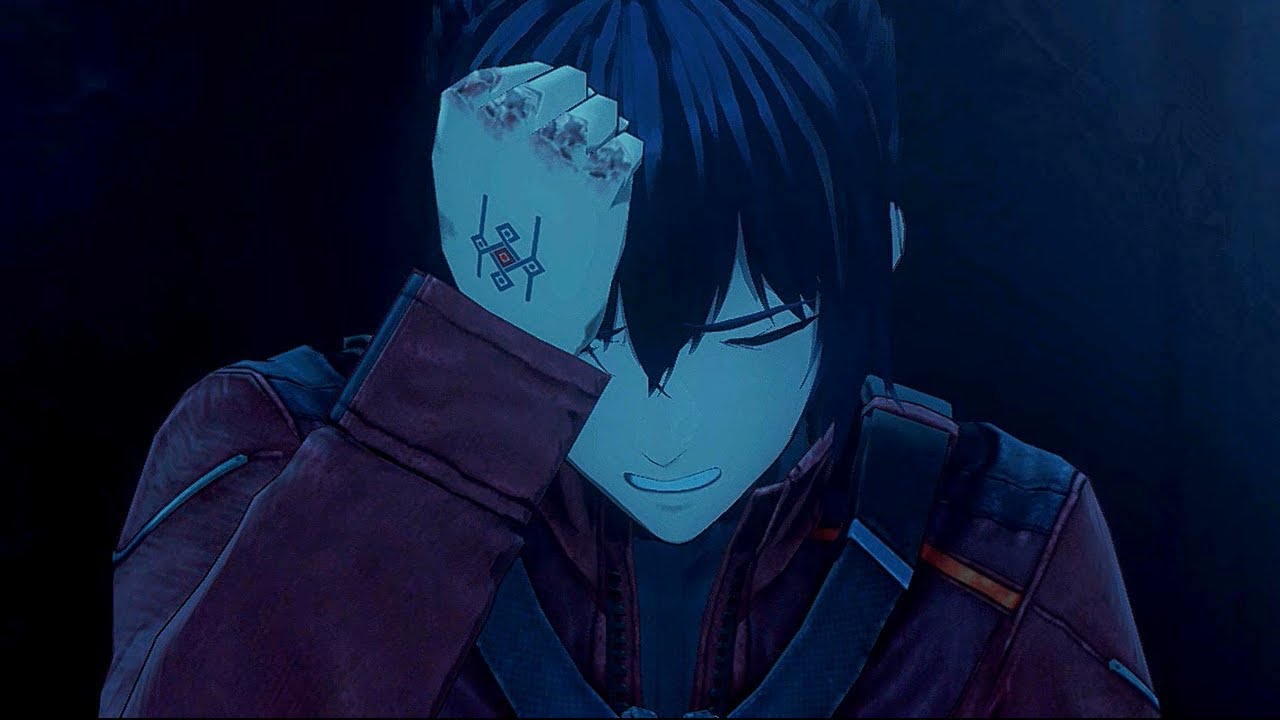 At its best, Xenoblade Chronicles 3 hits incredibly hard.
At its best, Xenoblade Chronicles 3 hits incredibly hard.
That's not to say it's all doom and gloom, though. Xenoblade Chronicles 3 smartly intersperses brief moments of levity between its heavier moments, allowing players to catch their breath before diving back into Aionios' harsh and desperate waters. But again, unlike Xenoblde Chronicles 2, these moments don't feel out of place in an epic sci-fi adventure, and don't resort to tired anime cliches in an attempt to connect with an audience.
Instead, these moments in Xenoblade Chronicles 3 are a little more grounded and mature, a little more tender and thoughtful. They lend humanity to the game's characters, who are simply trying to make light of their terrible existence.
In that sense, it's refreshing to see Monolith Soft take its universe a little more seriously. And even though there are major problems with this game's narrative and its characters (I'll get to that below), I'd argue that Xenoblade Chronicles 3's more-mature tone is a step in the right direction.
An Unwieldy, But Incredibly Rewarding, Battle System
There's no denying it: Xenoblade Chronicles 3's battle system is complicated. Perhaps a little too complicated. On top of that, the game introduces new wrinkles into the battle system as the player progresses, making it hard to settle into a comfortable groove until late in the game.
The game starts by introducing its core battle mechanics: auto-attacks, , character management (i.e. equipping accessories, leveling up, etc). The basics should click fairly quickly for those that have played RPGs before.
Then, as players progress, the game introduces more mechanics: , , , and . I'll admit that the game's constant use of made-up RPG jargon was overwhelming at times, and despite the game's abundance of tutorials, I'd often not fully grasp of a mechanic until several hours later. And yes, the sheer volume and relentlessness of Xenoblade Chronicles 2's tutorials, famously memed on by Dunkey, are back to pester the player.
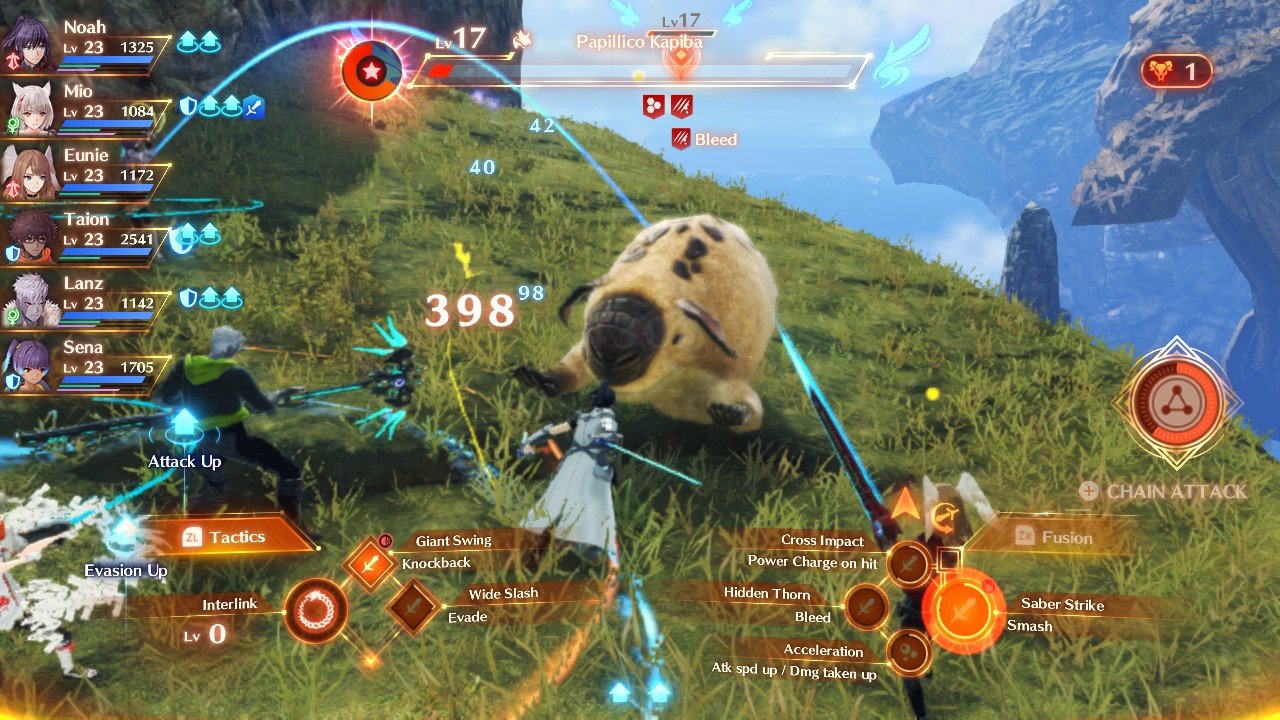 This screenshot will probably look bewildering to those unfamiliar with Xenoblade. There's lots to learn about Xenoblade Chronicles 3's battle system, but in my opinion, it's worth learning.
This screenshot will probably look bewildering to those unfamiliar with Xenoblade. There's lots to learn about Xenoblade Chronicles 3's battle system, but in my opinion, it's worth learning.
But during my playthrough, after about 25 hours, something awesome happened: the mental burden of Xenoblade Chronicles 3's numerous mechanics began to ease, and I started to view these mechanics as tools instead of as sources of confusion.
What do I mean by this? To give you some examples: want to turn Eunie, one of the game's default healers, into a critical-hit landing powerhouse? How about a tank that is frail but impossible to hit? Or maybe you'd rather put her in a support role that has insane synergies with one of your other attackers?
Unlike other RPGs that punish players for straying too far from conventional strategies, Xenoblade Chronicles 3 actively encourages it. The game urges players to constantly change characters' classes, and by doing so, characters can permanently learn a variety of unique and useful skills from other classes. For example, changing Lanz, the game's , into a healer will allow him to learn healing skills that he can carry with him regardless of his current class.
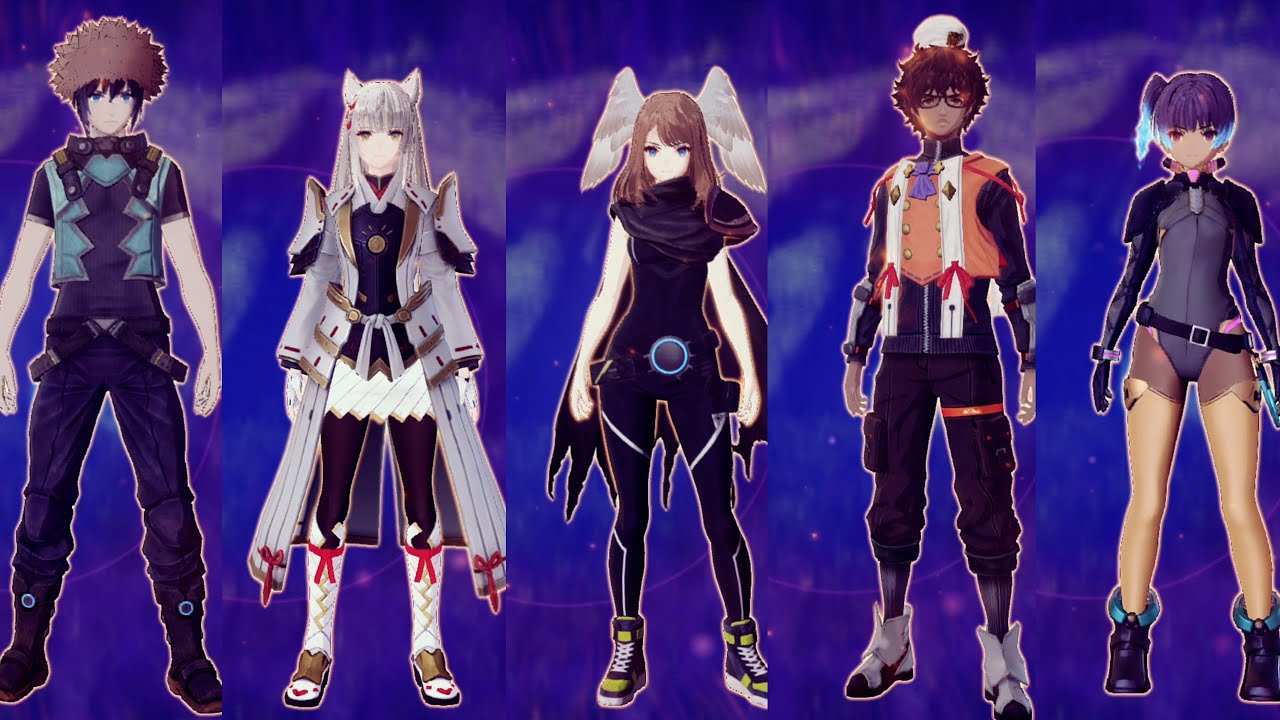 Changing classes is a great way to alleviate some of the tedium of using the same skills and abilities over and over. Plus, it allows characters to learn skills that they wouldn't otherwise be able to use.
Changing classes is a great way to alleviate some of the tedium of using the same skills and abilities over and over. Plus, it allows characters to learn skills that they wouldn't otherwise be able to use.
Xenoblade Chronicles 3 explicitly tells players to change classes once a current class has reached its maximum level, and by doing so, most players will naturally realize how fun and rewarding it can be to experiment with the game's class system.
Another notable feature is what the game calls "Fusion Arts". This mechanic allows players to perform two arts at once, and when doing so, any secondary effects of these arts are combined and amplified.
For example, consider the following two arts: one that is an art, and one that puts enemies to sleep. By "fusing" these two arts together, the result would put all enemies in the surrounding area to sleep. Pretty cool, right?
The art fusions possibilities are endless. Want a fusion art that both and lands critical hits? Or how about a fusion art that can buff your team and debuff an enemy at the same time? What about a fusion art that heals twice? All of these combinations are fair game in Xenoblade Chronicles 3, further proving my point that the only limit to the flexibility of this game's battle system is the player's own creativity.
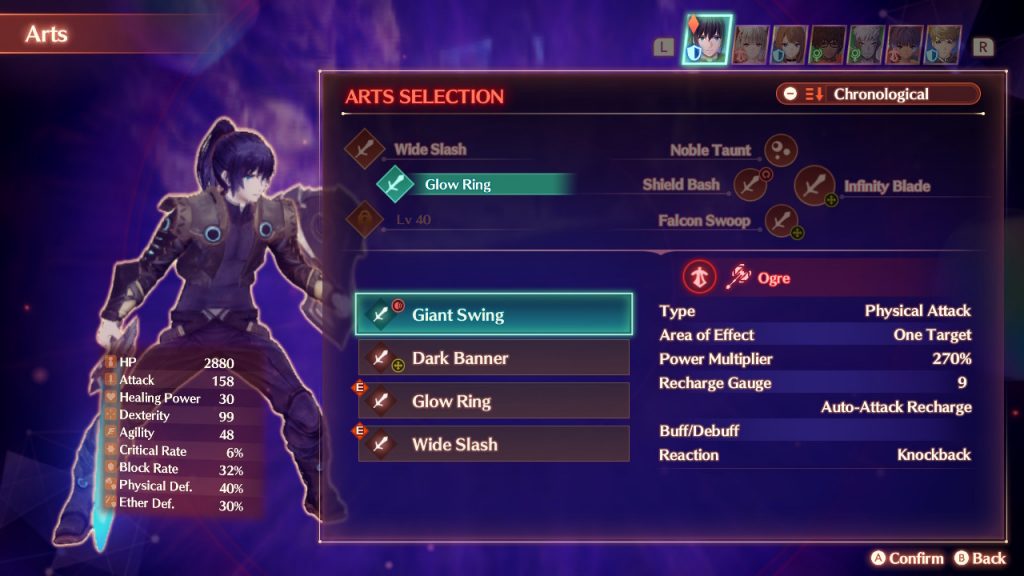 Xenoblade Chronicles 3's "Fusion Art" system opens the door for endless experimentations. While it can be a little overwhelming at first, it's incredibly satisfying to stumble on that perfect combination.
Xenoblade Chronicles 3's "Fusion Art" system opens the door for endless experimentations. While it can be a little overwhelming at first, it's incredibly satisfying to stumble on that perfect combination.
And on a final note, the game doesn't force players to deal with this complexity. When switching classes, the game helpfully sets some sensible defaults for arts, accessories, fusions, etc. In that sense, the game accommodates both the tinkerers and the easy-riders.
In summary, yes, the game's mechanics can be initially bewildering. But I'd argue that there's nothing quite like spending a good 20 minutes finding the perfect combination of classes and Arts, and then beating the absolute shit out of a previously-troublesome boss. These moments can be exhilarating, vindicating any early struggles a player may have.
Miscellaneous Goodness
While I want avoid making this review 100 pages, it wouldn't be fair for me to not mention the following:
- As expected, Xenoblade Chronicles 3's soundtrack is phenomenal. It's unlike anything else I've heard in a videogame. Its melodies are memorable and strong, but still manage to evoke the fantastical and the surreal.
- While , the voice acting from the main cast is much improved over its predecessor, sounding downright impressive at times.
- Loading screens are kept to an absolute minimum. Combined with a snappy menu, it's a joy to play a game that can actually with the player's inputs.
Disappointing in Many Respects
If you couldn't tell by now, there's a lot to love about Xenoblade Chronicles 3. But like the dual-natured world of Aionios, there is another side to Xenoblade Chronicles 3, one that is filled with tedious grinds, empty environments, and sleep-inducing dialog. I don't want to belabor the point, but I do think it's important to thoroughly justify my critiques instead of blithely stating, "this game is bad. The characters are boring. The story is bad".
Allow me, then, to argue my points.
A Conflicted Open-World Design
As a series that is renowned for its massively explorable environments, I want to first take a look at Xenoblade Chronicles 3's open world. At first glance, it definitely seems like lots of thought and care was put into its design: the terrain is varied, there are about a dozen different biomes, and there are plenty of callbacks to previous games in the series. With boatloads of icons to find on the game's minimap, the game certainly presents its world as "open", with a multitude of things to collect and discover.
Why, then, is the game so unwilling to let players explore it? For some reason, Xenoblade Chronicles 3 constantly thwarts any attempt at exploration with the following:
- Invisible walls blocking exploration until the current quest has been completed.
- Absurdly high-leveled enemies waiting to with too much curiosity.
- Dead ends and empty rooms. Only later will the player learn that this area will be used as a set piece for a future quest.
- Hills, cliffs, and ropes that can only be traversed if the player has learned the requisite skill (i.e. the ability to climb vines). This is neither rewarding or fun; it instead feels like a ploy to waste the player's time by forcing them to constantly backtrack.
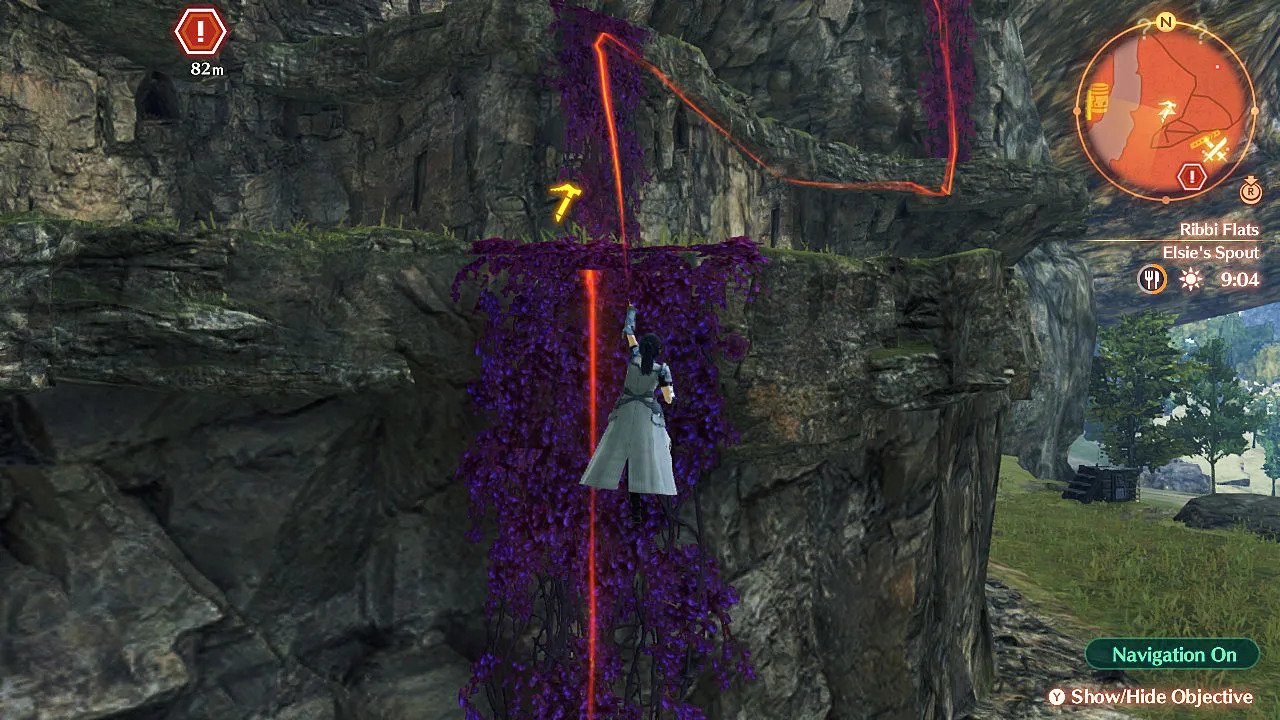 Found some cool vines to climb while exploring? If you don't have the climb ability, then too bad! You'll have to turn around.
Found some cool vines to climb while exploring? If you don't have the climb ability, then too bad! You'll have to turn around.
Does this sound like an open-world game to you?
The player is forced to endure this mockery of an open-world until about , which is when the game finally lets its guard down. There's no more invisible walls, all of the requisite climbing skills have been learned, and levels are likely high enough to take on most overworld enemies. So, the game is just a slow burn, right? Or as anime fans like to proclaim, "bro, just complete the first few chapters, and then it gets good"?
Well, not quite. The problem is that it will take most players about 40 hours to reach chapter 5. At this point, most players (like me) will already be burnt out from this game's lazy quest design, which mostly consists of .
Worse still is the fact that most quests in Xenoblade Chronicles 3 don't take advantage of its massive world, running the player through linear, uninteresting paths over and over again. This is why the introduction of the game's largest region, the Cadensia Region, didn't fill me with eagerness to explore its vast, endless sea. Instead, I was tempted to drop the game altogether.
This brings me to my next point.
An Empty, Unrewarding World
Once the game does open up, players will quickly learn that there's not really much to discover in Aionios. Sure, there are dozens of enemies wandering around the game's open areas, and the player's minimap is often covered with icons, suggesting a litany of people and things to find.
So, I suppose that "nothing to discover" isn't technically accurate. But I can say that there's nothing useful or interesting to find.
This is partially because, unlike past games, almost everything in the world of Aionios is marked on the game's map, removing the mystery and wonder of exploration. And once players have found an item or event, the corresponding map marker disappears. So, when there's no icons left on the minimap, that's a cue to players that there's nothing left to discover.
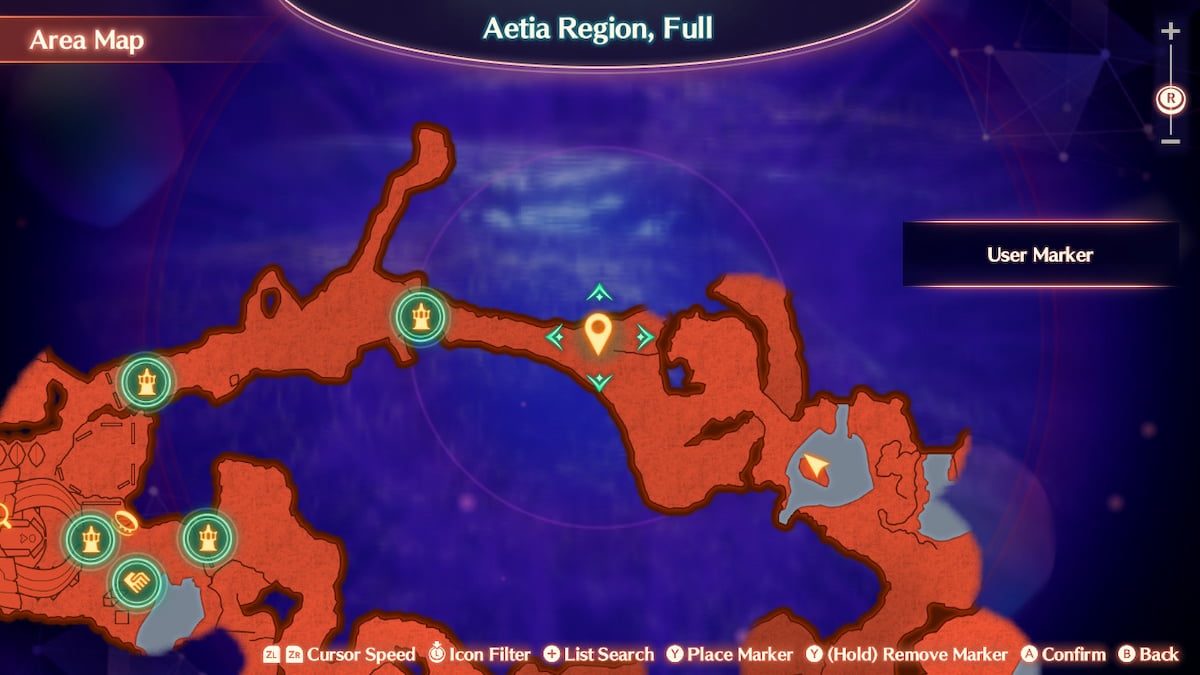 The minimap is almost too helpful at times, removing the need for players to actually learn the game's topography.
The minimap is almost too helpful at times, removing the need for players to actually learn the game's topography.
Sure, one could argue that this is a time-saving mechanic, but I'd argue that by removing the mystery of exploration, the incentive to explore vanishes. It certainly did for me, at least. Imagine if Zelda: Breath of the Wild conveniently marked every fairy fountain, shrine, and Korok seed on its minimap. It would totally change the experience, and arguably for the worse.
The other reason is that, despite the myriad of icons on the minimap, there's really only three things that the player can find:
- Colonies
- Item Containers
- Unique Overworld Monsters
Xenoblade Chronicles 3's colony system is half-baked, being a terrible substitute for the kinds of traditionally featured in RPGs. This is because the game's colonies are practically identical; other than having a different item shop, a different Hero, and a different backdrop, there's nothing to distinguish the colonies from each other. Sure, one colony might be in a cave, and another atop a snowy mountain, but functionally, they're identical. In fact, during my playthrough, I'd frequently get colonies confused, fast traveling to one when I meant to go to another.
The game initially makes a big deal out of these colonies, urging players to maximize each colony's "affinity chart". But to me, there's no reason to care about these charts because, proportionally, the rewards are absolutely meager compared to the work required for them. Think "Increased Swimming Speed" is an adequate reward for completing several lengthy fetch quests? No, not even close. And the "relationships" built between each colony's citizens mostly consist of nothing more than a handful of unvoiced text lines.
Worse, these colonies contain about a dozen or so NPCs, making the world of Aionios feel positively tiny. To me, it felt as if there were no more than 100 people, total, living in Aionis. I don't care if the sparseness of the colonies is "story-relevant"; it's a direct contradiction to the "wide open world" image that the game desperately tries to convey.
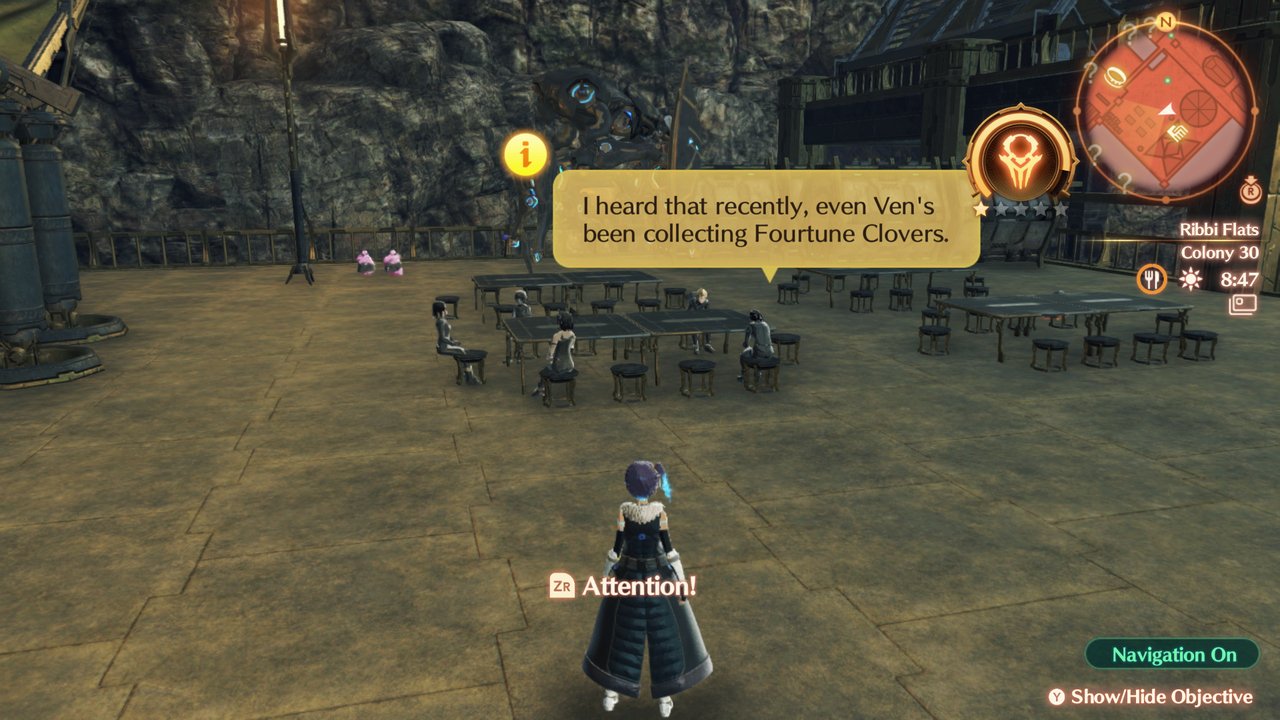 A couple of tents, a cafeteria, and some metallic structures and barricades. Sure, one colony might be in the snowy mountains, and another might be in a cave, but they all look like this.
A couple of tents, a cafeteria, and some metallic structures and barricades. Sure, one colony might be in the snowy mountains, and another might be in a cave, but they all look like this.
So, since the colony system in Xenoblade Chronicles 3 is lackluster, what about these "Item Containers"? At least players are rewarded with sweet loot, right?
Not exactly. These containers dispense , gemstones, and gold, with each one being useless in its own way:
- the requirements for crafting are so random and arbitrary that the chance of actually getting useful materials is incredibly slim.
- The amount of gemstones that a player need is actually capped to the couple hundreds. I reached the max amount after about 30 hours, so every subsequent gemstone I found was unceremoniously auto-sold.
- Gold is only used to buy accessories, and in my playthrough, the accessories on sale were never better than what I currently had equipped. Gold is so useless that it makes me think that Monolith Soft simply forgot about it during development.
I'm not exaggerating when I say that there was only a single time that I managed to find something useful in one of these containers: a unique accessory. And sure enough, after some research, I found that there's only 7 of these special containers in the entire game. Given that there's hundreds of these containers in Xenoblade Chronicles 3, the chances of the player finding anything worthwhile in these containers is incredibly tiny.
So, when everything is marked on the map, and 99% of what a player will find is disposable or uninteresting, there really isn't a compelling reason for the player to spend any time exploring Aionios. This is why Cadensia Region's grand reveal was dread-inducing instead of exciting. I wasn't thinking, "Yay! I get to explore!", but rather, "Oh god, let's get this over with".
But what about the battle system that I heavily praised? Beating down tough bosses can be its own reward, right?
A Time Consuming Grind
Despite Xenoblade Chronicles 3 making an honest effort to respect the player's time (auto saving, auto selling, a great navigation system, etc), this effort feels entirely absent from some of game's other elements. This omission is most noticeable during the game's bloated, lengthy battles.
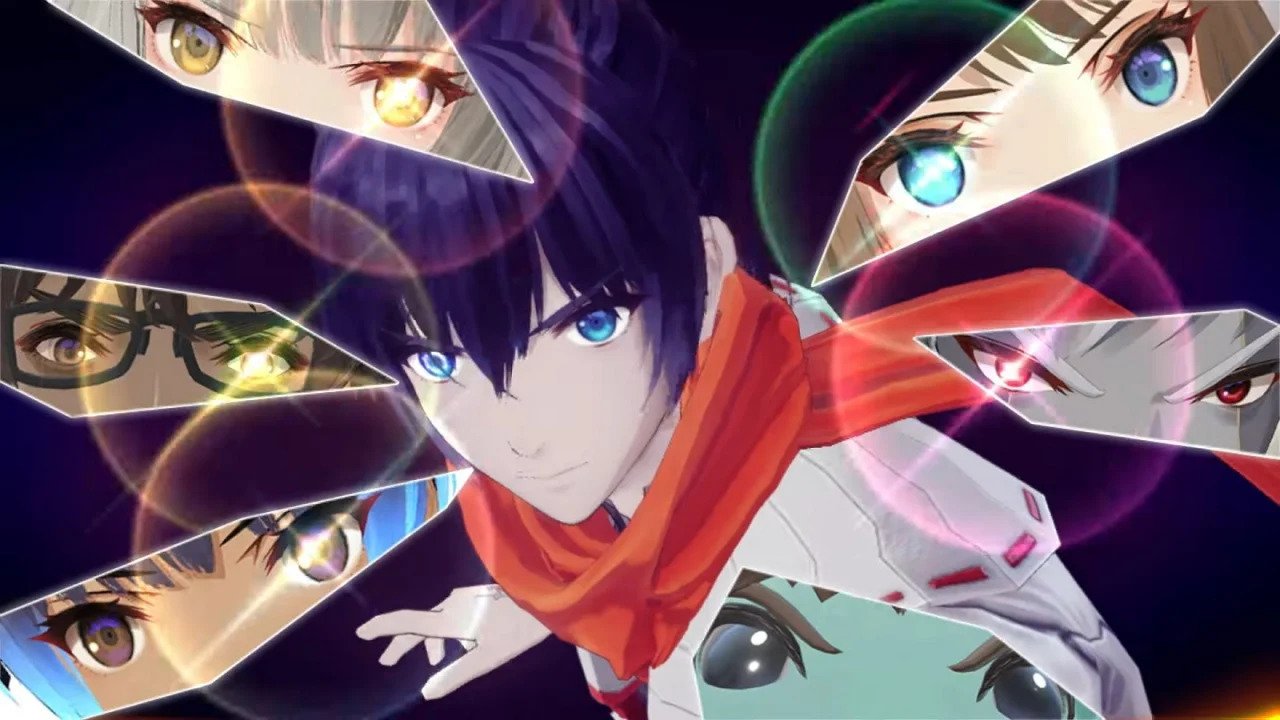 Chain attacks are useful, party-saving maneuvers, but are a chore to execute. Worse, they tack on an extra 5-10 minutes to each battle.
Chain attacks are useful, party-saving maneuvers, but are a chore to execute. Worse, they tack on an extra 5-10 minutes to each battle.
Make no mistake: I stand by my previous praise for the game's battle system. It's a wonderfully complex system that rewards careful study and patience, but is also flexible enough to accommodate most playstyles. The game's first half can be thrilling at times because both the party and the enemy have relatively tiny reserves of HP, which makes battles are brisk and exciting. Witnessing a huge swath of enemy HP disappear after executing a powerful attack was always satisfying, making me feel like my battle-time decisions had an impact.
But unfortunately, towards the latter half of the game, battles become a test of patience, rather than skill. Starting around chapter 5, unique monsters and bosses are given disproportionate buffs to their HP and lethality. Gone is the satisfaction from landing a powerful blow, as even the most powerful attacks deplete only a sliver of HP. As a result, many battles drag on for an upwards of 5-8 minutes, with boss/legendary monster battles taking around 10-15 minutes. I'm not joking. And that's if players beat a boss on their first try.
Since enemies become so resilient and lethal in the latter half of the game, "Chain Attacks" become both the only way to deal any significant damage (making the combo system practically useless), and the only way to survive (by stopping lethal blows and giving yourself time to heal).
The problem with the Chain Attack system, however, is that it stops time. In theory, this is good because it allows the player to craft the perfect sequence of 20-30 attacks, ensuring high damage output. But in practice, it's terrible because one Chain Attack takes about 3 minutes to execute. Since most bosses will require about 2-3 chain attacks to defeat, the average length of a boss battle will approach 20-25 minutes, which is simply far too long.
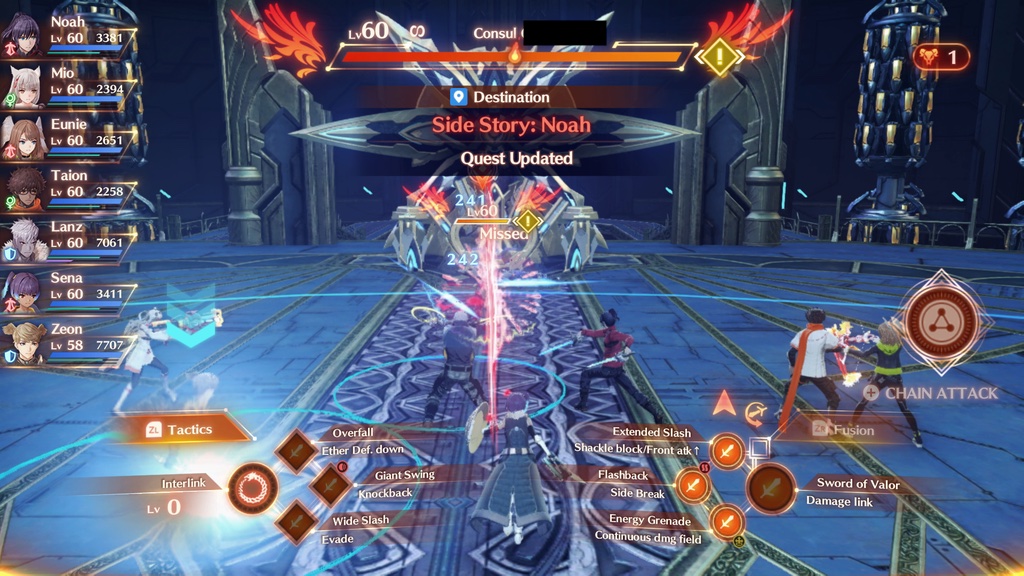 The game's Consul boss battles towards the later half of the game are particularly grueling.
The game's Consul boss battles towards the later half of the game are particularly grueling.
As a result, instead of being eager to take on higher-leveled enemies as I progressed, I was eager to avoid them. But true to its JRPG roots, many quests require the player to trudge through narrow passageways filled with endless, respawning hordes enemies, so an avoidance strategy isn't really feasible. This is ramped up to an unbearable degree for the last 10 hours of Xenoblade Chronicles 3, making it one of the worst segments in a video game that I've played this year.
So, at this point, I've established that the game's "open world" is a unrewarding chore to traverse, and the game's battle system crumbles under the weight of a poorly-balanced second half of the game. What, then, does that leave for the player to enjoy?
This a JRPG, right? Surely its story and characters are wacky, zany, and fun?
Lifeless Characters
Rather than discuss the plot, I first want to discuss Xenoblade Chronicles 3's characters because it's the characters, not the plot, that are the most important elements of a good story. The most interesting premise in the world wouldn't be able to save a story with lifeless characters. Inversely, some of the best games/shows of our generation have paper-thin plots, and are carried by their likable characters and nuanced portrayals of human behavior (i.e. the works of Shinchiro Watanabe).
While this topic deserves a separate essay, I'll spare you the details and leave you with a brilliantly-concise quote on the importance of characters in a story:
In that sense, the way that characters behave and develop is critically important in getting the audience invested in a story. They must be both realistic yet interesting, unique yet relatable, active yet contemplative. When a likable character falls, we feel pain. When a likable character triumphs, it's as if we've triumphed, too.
Xenoblade Chronicles 3, unfortunately, fails its characters in the worst way possible, and it's not because they're annoying, unlikeable, or poorly voice-acted. No, Xenoblade Chronicles 3's fails because its main characters are some of the most robotic, lifeless, and bland characters of any game that I've played in the past 10 years. The best way that I can describe them is unbearably inoffensive.
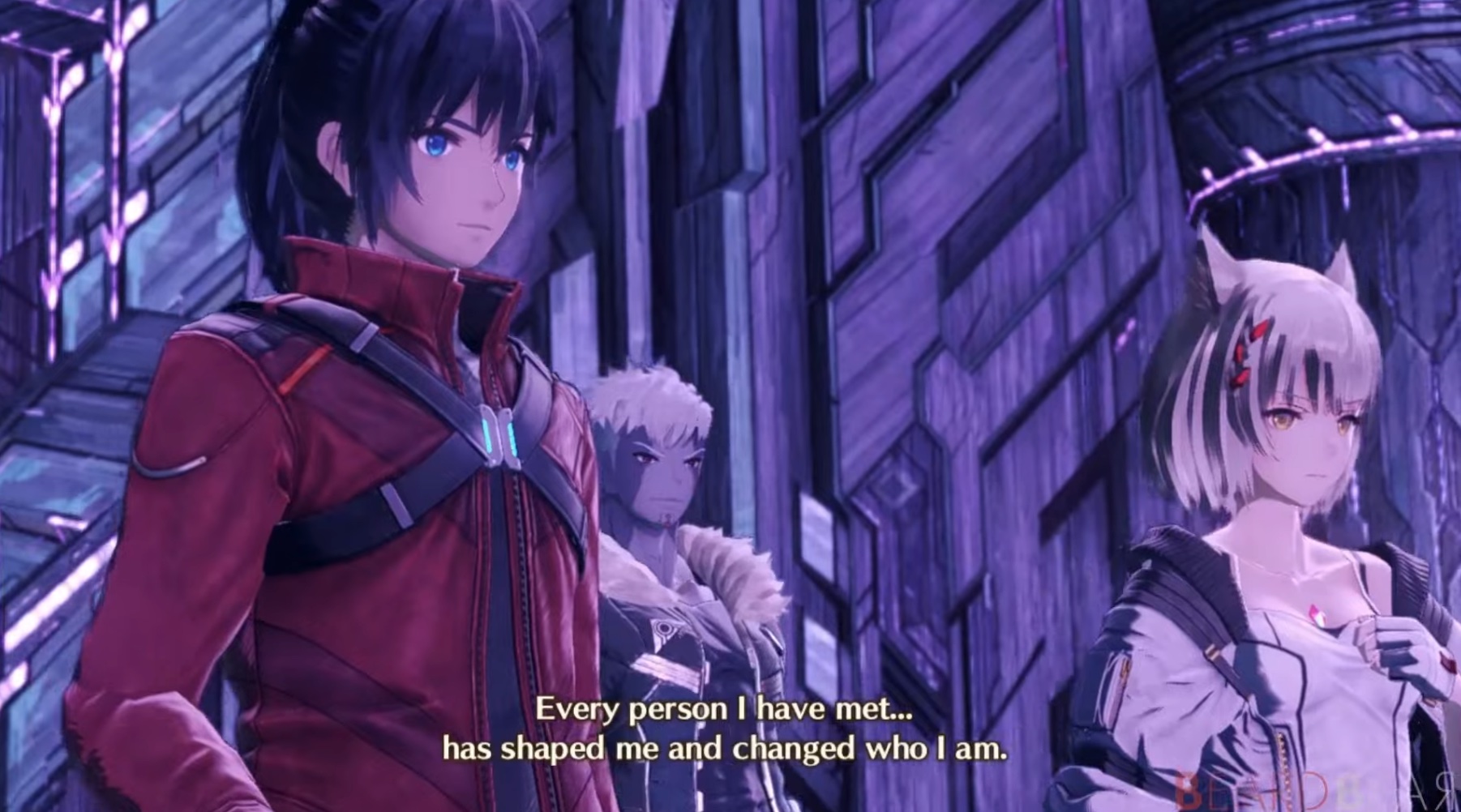 Like many JRPGs, Xenoblade Chronicles 3 doesn't seem to understand the concept of Show, Don't Tell
Like many JRPGs, Xenoblade Chronicles 3 doesn't seem to understand the concept of Show, Don't Tell
This is not, however, immediately apparent in the opening hours of Xenoblade Chronicles 3: the game's first 5-10 hours contain several charming, nuanced cutscenes that show off the colorful sides of the game's main cast. I'll admit that, similar to Tales of Arise, another JRPG that I've reviewed, I was fooled into thinking that I was getting myself into a gripping, character-driven narrative.
The game continues this charade by making each member of the main cast a little "broken" in some way. For example, Eunie has PTSD from a previous encounter with a villain. Taion lives with shame because he blames himself for the death of his crush friend. Sena's desperation for acceptance from her peers has made her lose her sense of self. Most of Xenoblade Chronicles 3's characters have some "quirk" like this that gives off an illusion of depth and nuance.
In that sense, Xenoblade Chronicles 3 certainly plants the seeds for compelling character arcs, but unfortunately, we don't get to see the process by which these seeds blossom. Instead (to continue this silly metaphor), players stare at these seeds for 80 hours until, poof, they suddenly become giant oak trees.
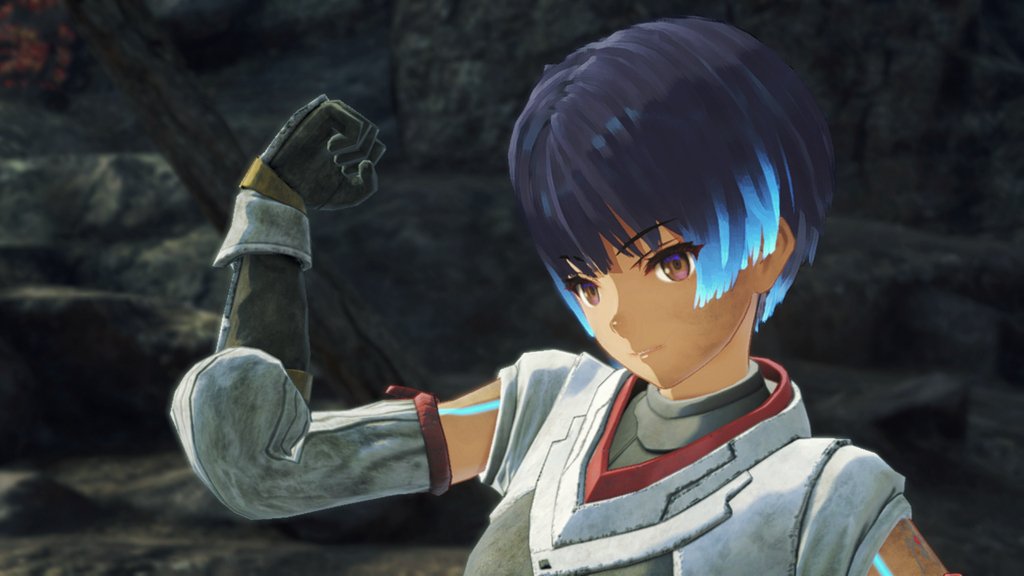 Xenoblade Chronicles 3 spends a lot of time telling us that Sena's psyche is overly-reliant on praise and validation from others, but this is completely irrelevant to her part in the game's story.
Xenoblade Chronicles 3 spends a lot of time telling us that Sena's psyche is overly-reliant on praise and validation from others, but this is completely irrelevant to her part in the game's story.
For example, the characters tell us that Mio is troubled about her impending 10-year death, but we never see that fear play out (in fact, the game's diary motif is randomly used, and never in a compelling way). The characters tell us about Taion's guilt, but it never factors into his decision making (aside from some minor events in an entirely-optional side quest). The characters tell us that Lanz is torn up over a betrayal from one of his long-time friends, but this never affects his behavior or his attitude towards his other friends.
These characters claim to be "broken", despite not acting like it. Instead, each character is intelligent, rational, trusting, and kind, but the game tries to tell players something to the contrary. Repeatedly and endlessly. It tells us, but never shows us.
In addition to lacking any sort of believable character development, Xenoblade Chronicles 3's characters don't behave like humans, either: they never debate, and they never disagree. They always assume the best intentions, and they never hold grudges.
Despite having 6 characters with which to create interesting group dynamics, the game plays things as safely and as boring as possible. Aside from one bizarre moment where Mio unexplainably gets angry at Noah (and then quickly forgives him), there's no tension or drama between them to speak of.
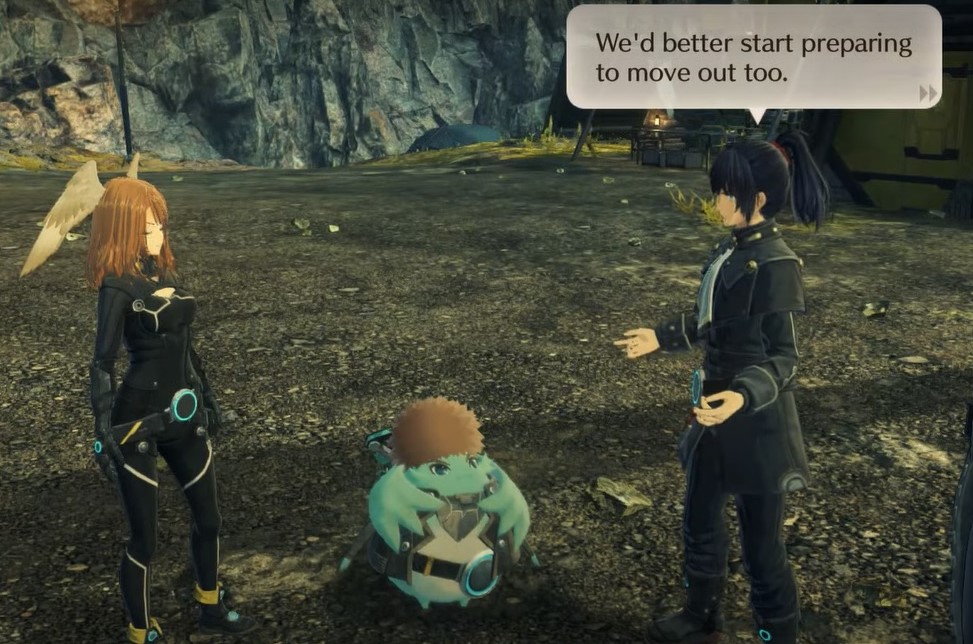 It may not be apparent at first, but most of the game's dialog is delivered via unvoiced, awkwardly-animated scenes filled with text boxes.
It may not be apparent at first, but most of the game's dialog is delivered via unvoiced, awkwardly-animated scenes filled with text boxes.
But...shouldn't there be? If multiple universes were on the brink of total annihilation, and the world's citizens were forced into servitude, don't you think the game's protagonists might have different opinions on how to handle this? Don't you think that they'd get a little hot-headed at times? Don't you think that tensions would rise, feelings would get hurt, and emotional scars would be formed?
Most importantly, don't you think that being introduced to the concepts of babies and sex would drastically alter the dynamics between six young adults?
Monolith Soft doesn't seem to think so. Instead, Xenoblade Chronicles 3 is content to tell us how this long journey has changed these characters, instead of demonstrating this to its players in any meaningful way.
So, when Xenoblade Chronicles 3's players characters repeatedly chirp that they've "changed" by the game's conclusion, these proclamations ring hollow because the game hasn't given its audience any reason to believe it. In reality, they haven't changed one bit: they're the same logical, cool-headed people that they've always been. This makes Xenoblade Chronicles 3's characters feel like walking plot devices, rather than relatable human beings.
This is exacerbated by a wonky, uneven localization. At times, characters don't even properly respond to direct questions, and non-sequiturs are frequent throughout the game's script. It's almost as if the game's japanese script was thrown through a Japanese-to-English translator program and then slightly touched up, rather than organically written by a human being. It's most apparent when the game tries to wax philosophical, using strange metaphors and clunky phrasing that elicit wincing, rather than pondering.
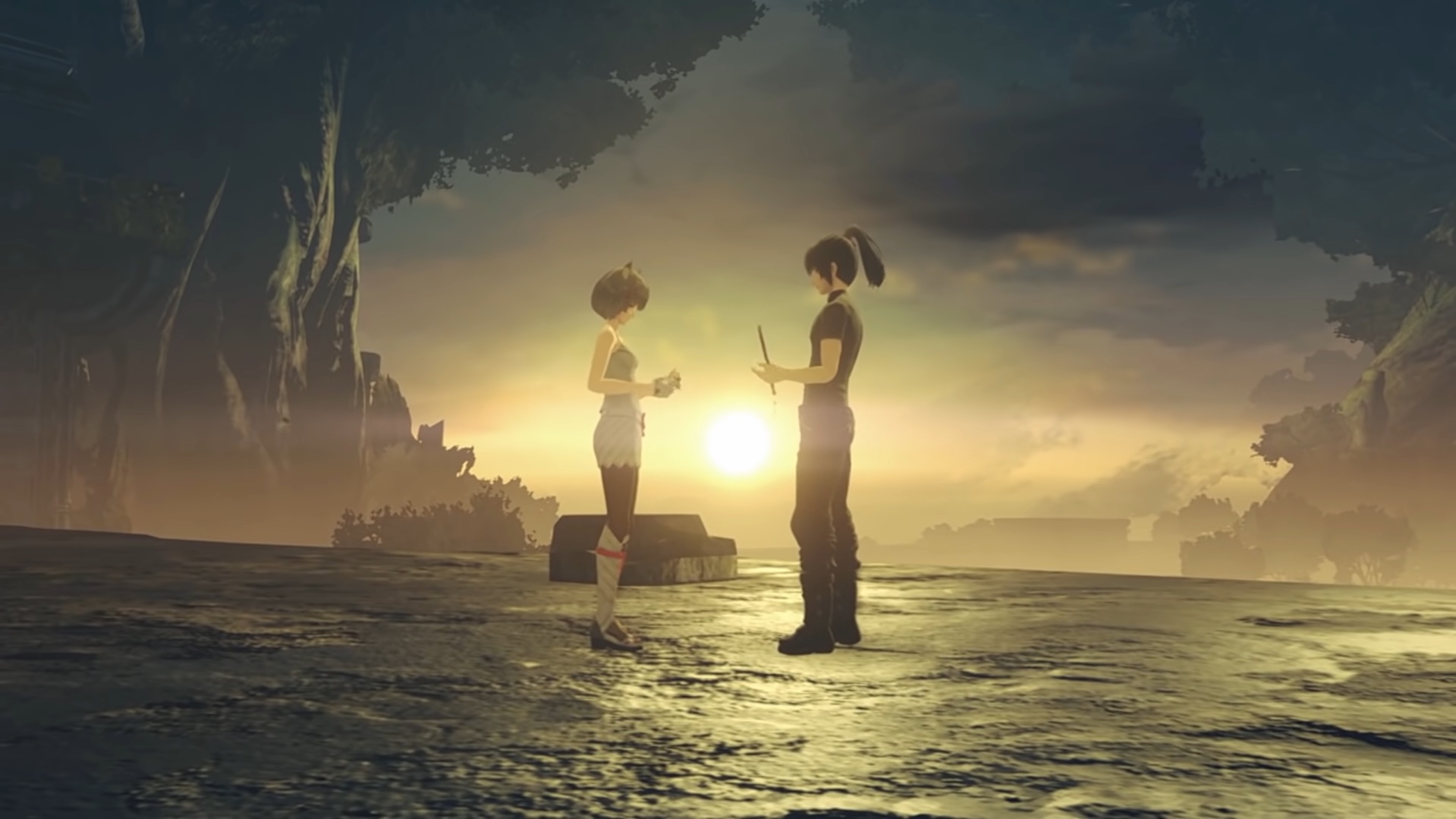 Xenoblade Chronicles 3 fumbles this moment with robotic dialog and lifeless character interactions.
Xenoblade Chronicles 3 fumbles this moment with robotic dialog and lifeless character interactions.
What, then, did I feel for the game's main cast as the end credits began to roll? Honestly, not much. I couldn't see myself, or anyone else for that matter, in Noah or Mio. So when they persevered, I felt nothing.
In all honesty, I'm just barely able to restrain myself from saying that I prefer Xenoblade Chronicles 2's obnoxious cast of characters to this crew. Sure, those characters suffered from terrible writing and one-dimensionality, but at least they were fun.
Also, notice that I haven't touched on the game's "Hero" characters, since most of them are only obtained through optional side quests. This means that, outside of the one or two quests that directly pertain to a given Hero, the player won't hear a peep out of them for the rest of the game. These Hero characters are, quite literally, irrelevant to plot. And since they're mostly optional, their relationships with the main cast don't amount to anything significant, either.
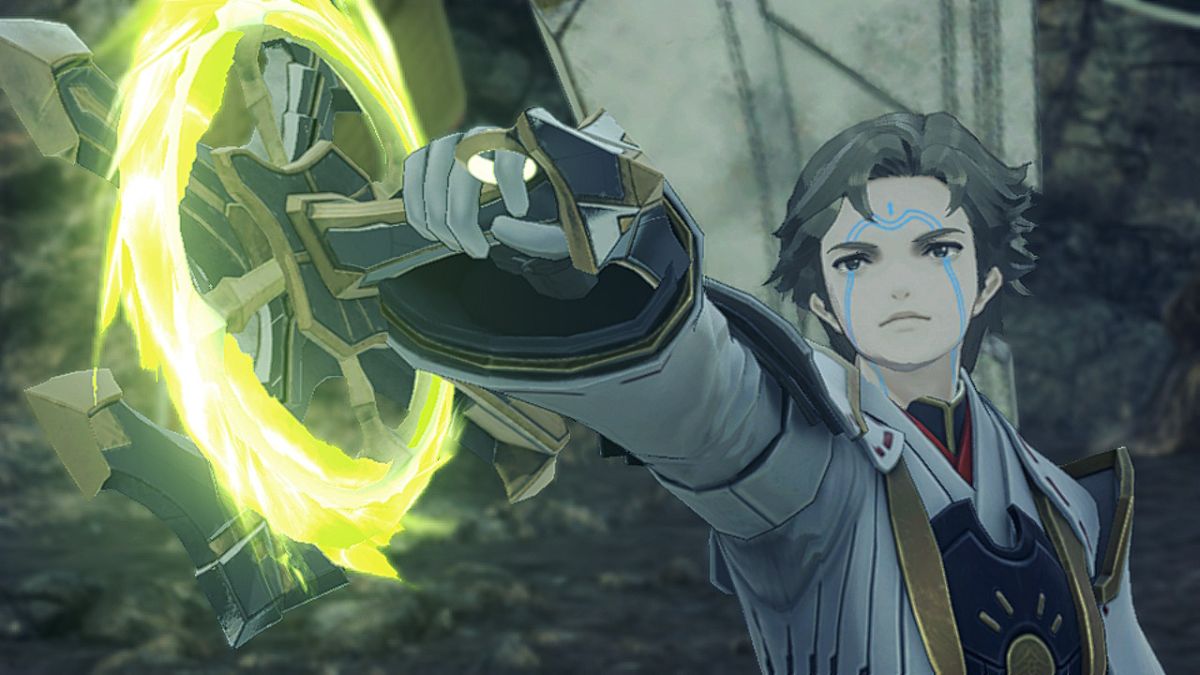 Isurd wins the award for least interesting character in the game. It doesn't help that his voice actor sounds as if he's just woken up from a nap.
Isurd wins the award for least interesting character in the game. It doesn't help that his voice actor sounds as if he's just woken up from a nap.
Before you reach for your keyboard to angrily exclaim "OMG are you an idiot??? What about THIS scene?!?!", yes, there are occasional sparks of life in Xenoblade Chronicles 3's characters, and those sparks sometimes shine very brightly. In particular, the "jail" cutscene is one of the most heart-wrenching, masterfully-crafted cutscenes in the entire Xenoblade franchise. There's also a between Taion and Eunie that suggests that someone at Monolith Soft might understand the concept of "Show, don't tell". And finally, yes, Eunie can be a hoot.
But ultimately, these glimmers of humanity get absolutely crushed under this game's 60 hours of tactless, repetitive noise, making it impossible to truly connect with any of these characters. For a studio that obviously spent a lot of time designing the ultra-likeable Shulk from Xenoblade Chronicles, I was shocked at how indifferent I was to Noah and Mio.
An Long, Uneventful Story
I've mentioned a few times that Xenoblade Chronicles 3 is a long game. This isn't necessarily a problem, as many great games from this generation have long runtimes. Whether it's because of a compelling gameplay loop or an exciting storyline, games like Zelda: Breath of the Wild, Skyrim, and The Witcher 3 prove that it's possible to captivate audiences for dozens of hours.
Unfortunately, the same cannot be said for Xenoblade Chronicles 3. I reached the end of the game about a month ago, and yet I'm sitting here, struggling to recall what actually happened in its story. Sure, players will learn more about the Xenoblade Chronicles 3 universe and its characters over the course of the narrative, but there's surprisingly little activity over the game's 60 hour runtime. Or at least, activity that involves the player.
Off the top of my head, I can only think of blowing up the big world-destroying laser, reaching The City, going to Prison, getting a random key from Nia, and fighting Consul Z. That's it. Now, try to imagine how on earth this game can stretch these events over the span of 60 hours. Obviously, it can't.
Instead, outside of the game's opening act, nothing really happens until players hit the 30 hour mark. And at that point, the game squanders all of its narrative momentum, sending the player on dozens of sleep-inducing fetch quests and having them sit through stilted, voiceless cutscenes.
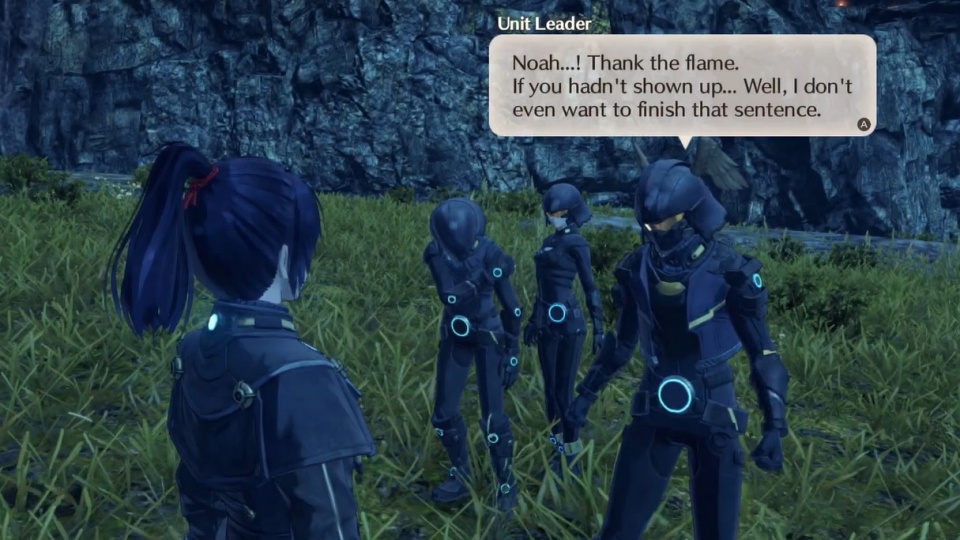 Xenoblade Chronicles 3 devotes way too much time to its side characters. Some could call it "world-building", but given how uninteresting they are, I'd call it "filler".
Xenoblade Chronicles 3 devotes way too much time to its side characters. Some could call it "world-building", but given how uninteresting they are, I'd call it "filler".
Part of the problem, I think, is that most of the events integral to Xenoblade Chronicles 3's plot have already happened by the time the player picks up a controller. Noah has already impregnated Mio and succumbed to the dark side, Melia and Nia have already constructed Origin and left to take naps, and Consul Z has already set his plan in motion for "the endless now".
One of the hardest challenges for a story that is focused on the past lives of its characters is that, when the story mostly focuses on the past, it doesn't leave a lot of room for the present. Zelda: Breath of the Wild shares this issue with Xenoblade Chronicles 3 in that the player isn't an active agent for most of the story's narrative events. So, instead of being an active participant in major plot events, Xenoblade Chronicles 3 has player wait on the sidelines until the dust has settled, making them feel disconnected from the narrative's progression.
For example, Ethel and Cammuravi supposedly have a long, storied rivalry? Supposedly, Crys was incredibly inspiring to Noah when he was younger? Supposedly, everybody has always loved Joran? Really?
I don't care how many sepia-toned flashbacks the game throws at me: telling an audience to care about characters, but not spending the time or effort to develop those relationships organically, is a terrible way to tell a story.
This is why Xenoblade Chronicles 3's length is so baffling to me: it clearly has no problem asking the player to spend 60+ hours on it. But in return, the player has practically nothing to show for it, narratively speaking, by the game's conclusion.
I won't even get into the number of plot threads that the game's ending never addresses (i.e. who, exactly, is Riku?). I sincerely hope that this is due to a rushed development process, rather than a ploy to get players to buy additional DLC down the line.
An Anti-Climactic Conclusion
On one final note, as a Xenoblade series fan, I can't help but mention how disappointing Xenoblade Chronicles 3's ending is. I'll admit that this criticism isn't relevant for those that haven't played Xenoblade Chronicles 1 or 2, but I think it deserves to be said.
Xenoblade Chronicles 1 ended with a huge, earth-shattering twist that recontextualized its entire plot. Similarly, Xenoblade 2 obscured its connection to its predecessor until the very end, greatly expanding on the series' lore and providing major contextual twists of its own.
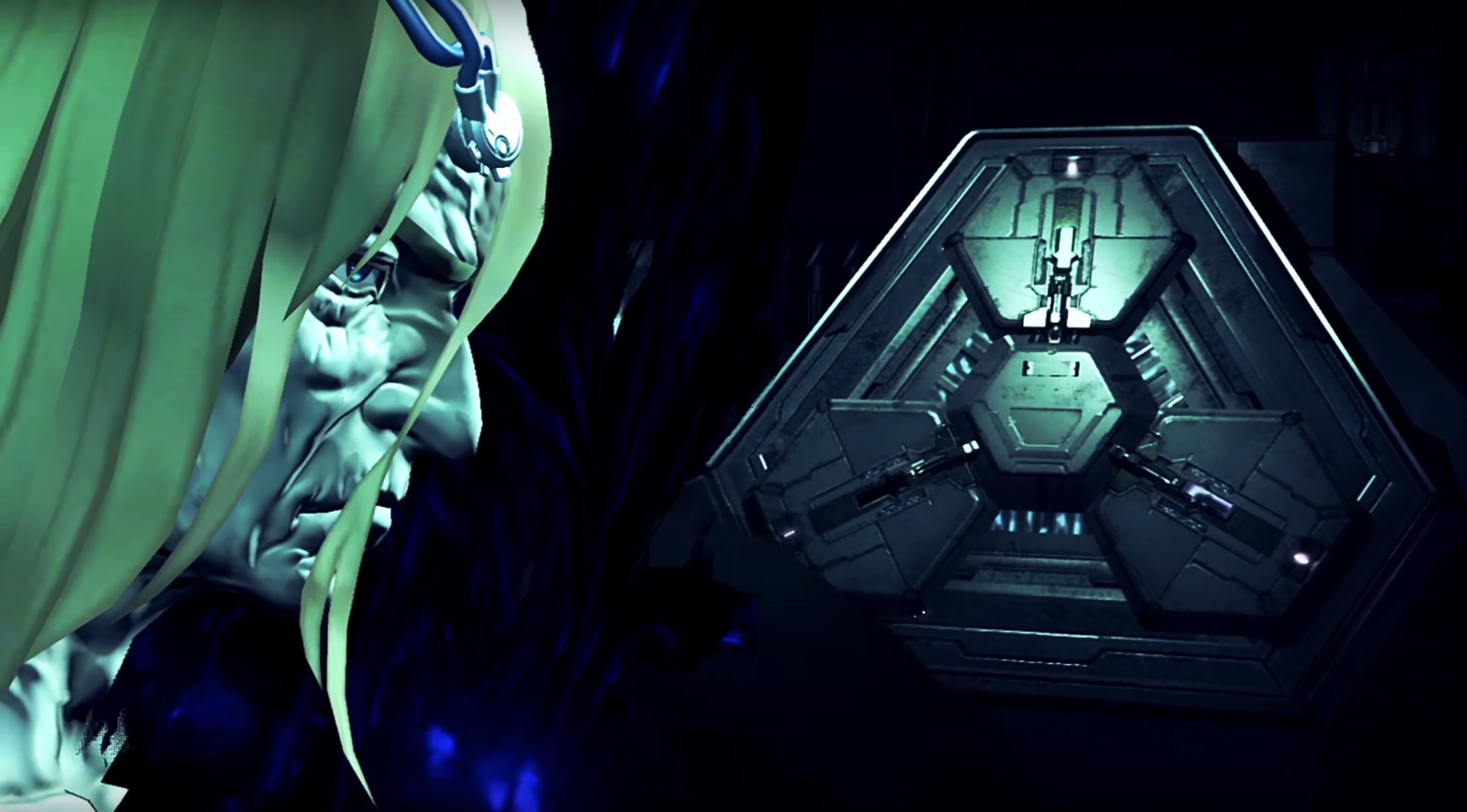 For those that played Xenoblade Chronicles 2, I'm sad to report that there's no equivalent scene like this in Xenoblade Chronicles 3.
For those that played Xenoblade Chronicles 2, I'm sad to report that there's no equivalent scene like this in Xenoblade Chronicles 3.
But unlike its predecessors, Xenoblade Chronicles 3 stumbles and sputters over the finish line. There's hardly any lore revelations, and there aren't any major twists (that aren't painfully obvious).
Instead, the game simply wraps itself up as timidly and as conservatively as possible. In fact, I'd argue that the ending veers dangerously close to the "It was all a dream! Or...was it?" trope, although I suppose that one could argue for more nuanced interpretation.
Still, in the context of its predecessors, it's shocking to me that , almost literally, almost nothing happens by the end of the game. I understand that the developers wanted to keep this game somewhat self-contained rather than assume players have played previous games in the series, but they went completely overboard in this regard.
Don't even get me started on the game's contrived, totally-unearned kiss between Mio and Noah. I recognize that it's against the law to not have JRPG male and female protagonists fall for each other, but this particular romance felt especially inorganic and completely forced..
I suppose that I'm probably coming across as an "entitled gamer", but honestly, I expected more from this series. Hell, the only reason I put 100 hours into this game was because of a faint hope that, like its predecessors, Xenoblade Chronicles 3's conclusion would rock my world.
In short: this game is bad. The characters are boring. The story is bad. The End.
Conclusion
I kid, I kid. It seems like the more I think about this game's wasted potential, the more frustrated I get, hence the increasingly-angry tone towards the end of this review.
But wow, that's a whole lot of words. Still with me?
Maybe I've taken things too far. Maybe a game like Xenoblade Chronicles 3 doesn't need a 20,000 page essay. Maybe it's simply meant to be appreciated for what it is: a sophomoric work that has some serious mechanical and technical merits, but hasn't outgrown its awkward JRPG roots. Maybe it deserves to be loved, warts and all, for what it sets out to do?
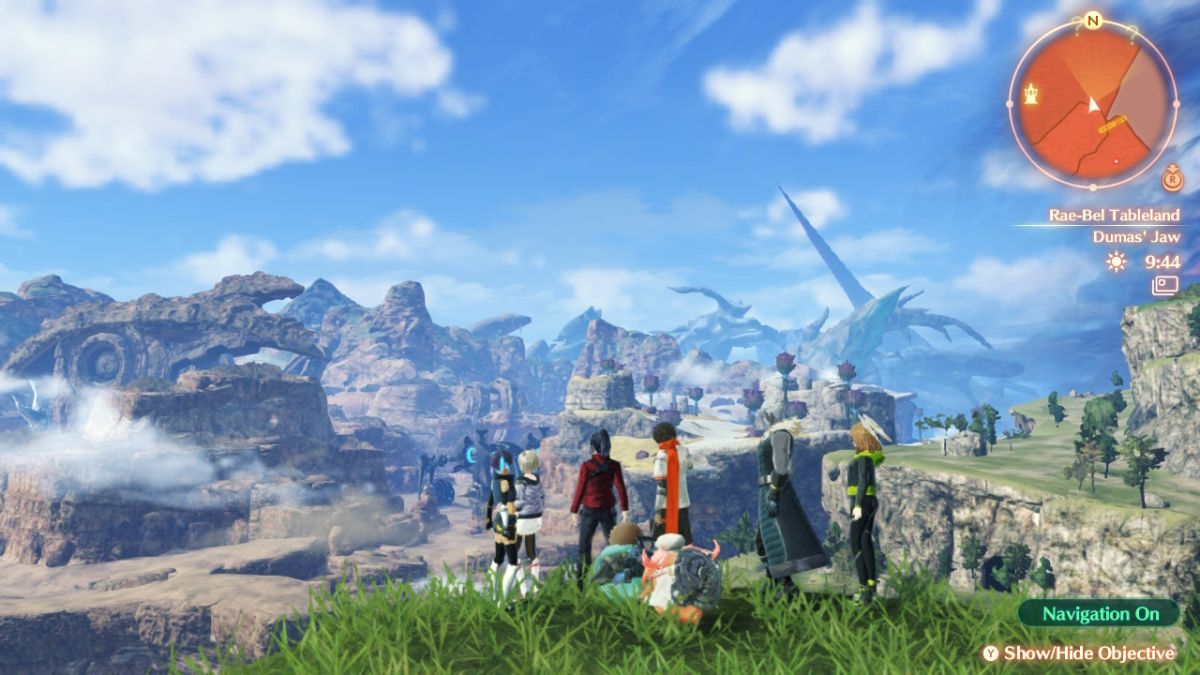 If nothing else, Xenoblade Chronicles 3 succeeds it sets high expectations for Xenoblade Chronicles 4.
If nothing else, Xenoblade Chronicles 3 succeeds it sets high expectations for Xenoblade Chronicles 4.
That's certainly a valid viewpoint; I would never take that away from someone, since that's how I feel about Xenoblade Chronicles 2. I would never call that game a "perfect game", but it is one of my favorites. Unfortunately, I can't say the same thing about Xenoblade Chronicles 3, but maybe others can.
Still, for all the things that Xenoblade Chronicles 3 does wrong, there's enough good stuff here to make it a game worth playing (depending on your tastes and tolerances, of course). It's also exciting to consider Xenoblade Chronicles 3 as a stepping stone towards something great. Fantastic, even.
Hopefully, Monolith Soft will be granted more time, a bigger budget, better hardware, and a pandemic-free environment when they start their next adventure.
Until then, I'll be eagerly waiting, listening to Xenoblade Chronicles 3's soundtrack in the meantime.
Verdict: 3 Rare Doodads Out of 5
Comment Policy: no flamewars or trolling. Just have fun and be nice!
